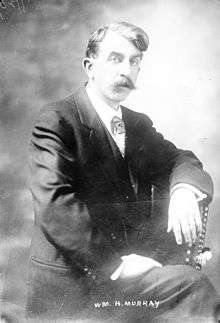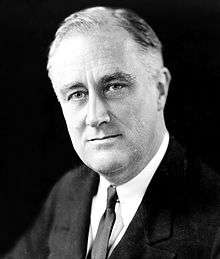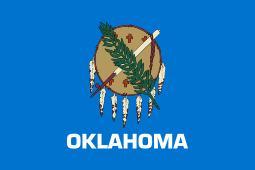William H. Murray
| William H. Murray | |
|---|---|
 Murray circa 1913 | |
| 9th Governor of Oklahoma | |
|
In office January 12, 1931 – January 15, 1935 | |
| Lieutenant | Robert Burns |
| Preceded by | William J. Holloway |
| Succeeded by | Ernest W. Marland |
| Member of the U.S. House of Representatives from Oklahoma's At-large district | |
|
In office March 4, 1913 – March 3, 1915 | |
| Preceded by | (district created) |
| Succeeded by | (district eliminated) |
| Member of the U.S. House of Representatives from Oklahoma's 4th district | |
|
In office March 4, 1915 – March 3, 1917 | |
| Preceded by | Charles D. Carter |
| Succeeded by | Tom McKeown |
| 1st Speaker of the Oklahoma House of Representatives | |
|
In office 1907–1909 | |
| Governor | Charles N. Haskell |
| Preceded by | None |
| Succeeded by | Ben Wilson |
| Personal details | |
| Born |
William Henry Davis Murray November 21, 1869 Collinsville, Texas |
| Died |
October 15, 1956 (aged 86) Tishomingo, Oklahoma |
| Resting place |
Tishomingo City Cemetery 34°13′38.6″N 96°40′43.3″W / 34.227389°N 96.678694°W |
| Political party | Democratic |
| Spouse(s) | Mary Alice Hearrell Murray |
| Profession | Teacher, lawyer |
| Religion | Methodism |
William Henry Davis "Alfalfa Bill" Murray (November 21, 1869 – October 15, 1956) was an American teacher, lawyer, and politician who became active in Oklahoma before statehood as legal adviser to Governor Douglas H. Johnston of the Chickasaw Nation. Although not American Indian, he was appointed by Johnston as the Chickasaw delegate to the Convention for the proposed State of Sequoyah, and was later elected as a delegate to the constitutional convention for the state of Oklahoma.
Murray was elected as the first Speaker of the Oklahoma House of Representatives after statehood, as U.S. Representative, and as the ninth Governor of Oklahoma (1931–1935). His campaign was marked by racist appeal and he supported Jim Crow laws. During his tenure as governor in years of the Great Depression, he established a record for the number of times he used the National Guard to perform duties in the state and for declaring martial law.
Early life and education
William Henry Davis Murray was born in the town of Toadsuck, Texas (renamed "Collinsville" in the 1880s), on November 21, 1869. He was born to Uriah Dow Thomas Murray, a farmer, and Bertha Elizabeth Jones.[1] His mother died when he was two years old and, after his father remarried, the family moved to Montague, Texas. At the age of twelve, Murray left home.[2]
During most of Murray's adolescence, he worked on farms during the summer and attended public schools in the winter. Murray worked and studied hard, and was admitted to the College Hill Institute in Springtown, Texas. He graduated from College Hill with a teaching degree in 1889 and began teaching in a public school in Parker County, Texas.[1]
Murray became politically active and joined the Farmers' Alliance and the Democratic Party. He was a skilled orator and campaigned for James Stephen Hogg when the latter ran for Governor of Texas.[1]
Early career
Murray then moved to Corsicana, Texas, where he founded a newspaper that survived for only two years. During this time he ran for the state senate, but failed both attempts.[1] He moved to Fort Worth, Texas, where he worked as a writer for the Fort Worth Gazette. While at College Hill, Murray had taken an interest in law and "read the law" in Fort Worth. He passed the Texas bar exam in 1897, and first practiced law in Fort Worth, Texas.[1]
Indian Territory
In 1898, Murray moved to Tishomingo, the capital of the Chickasaw Nation in the Indian Territory (now eastern Oklahoma), where he started a law practice. Murray's legal knowledge and colorful personality brought him to the attention of Douglas H. Johnston, the Governor of the Chickasaw Nation, who appointed him as legal advisor. In addition to practicing law in Tishomingo, Murray began to learn farming.
He acquired his nickname "Alfalfa" around 1902 while working as a political operative for Palmer S. Moseley, gubernatorial candidate for the Oklahoma Territory. Murray frequently toured to give talks to local farmers about politics and farming. He often referred to a large tract of alfalfa which he cultivated. Arthur Sinclair, who heard one of his speeches, reported to the editor of the Tishomingo Capital-Democrat that he had just seen "Alfalfa Bill" deliver one of his finest speeches. The name stuck with Murray for the rest of his life.
Marriage and family
On July 19, 1899, Murray married Mary Alice Hearrell, niece of Chickasaw Governor Douglas H. Johnston.[1] She was born January 9, 1875 and died August 28, 1938, and is buried in Tishomingo Cemetery.[3] They had five children together.[4] A son, Johnston Murray, born in 1902, was elected Governor of Oklahoma in 1951.
States of Sequoyah and Oklahoma
Murray's relationship with the Chickasaw governor Johnston benefited his political career. By 1903, American Indians of the Five Civilized Tribes were talking of seeking statehood for Indian Territory as an independent, Indian-controlled state, to be called the State of Sequoyah.
In 1905, the tribes organized a convention to draw up a state constitution. Governor Johnston appointed Murray to represent the Chickasaw at the convention in Muskogee. Of the six delegates at the convention, four were Native Americans; Murray and Charles N. Haskell were the only non-tribal, European Americans. The delegates drafted a constitution, which in a referendum was overwhelmingly approved by the voters of the Five Tribes.
Trying to avoid a state that might be dominated by Democrats (because of the Five Civilized Tribes' origin in the Southeast and histories of slave-holding and alliance with the Confederacy in the Civil War), President Theodore Roosevelt, a Republican, opposed separate statehood for Sequoyah. Roosevelt insisted that the Indian and Oklahoma territories had to be admitted as one state – Oklahoma.
In response to Congress's passage of the Enabling Act in 1906, the people of the two territories held a joint convention. Murray was elected as the delegate for District 104, which included Tishomingo. At the convention in Guthrie, Murray worked closely with Robert L. Williams and again with Charles N. Haskell. They became lifelong friends and allies.
Due to his experience in Chickasaw politics, Murray was elected by the delegates as the President of the Convention. He kept Haskell close to him; one newspaper reported the latter was the "power behind the throne." Together, the two men controlled the convention. The Oklahoma Constitution produced under their guidance was substantially based on the Sequoyah constitution.
The proposed constitution included white-supremacist and segregationist clauses strongly supported by Murray. President Roosevelt objected to these clauses, and obtained their deletion before the constitution was submitted to Congress. The US Congress admitted Oklahoma to the Union as the 46th state on November 16, 1907.
Oklahoma politics
With the state constitution in place, elections were held in 1907 for offices of the new state government. Murray was elected as a state representative, and became the first Speaker of the Oklahoma House of Representatives.[5] His ally Charles Haskell was elected as governor.
As speaker, Murray often opposed the progressive work of Kate Barnard, Commissioner of Charities and Corrections, and pushed for Jim Crow laws similar to those in southern states to control blacks. "We should adopt a provision prohibiting the mixed marriages of negroes with other races in this State, and provide for separate schools and give the Legislature power to separate them in waiting rooms and on passenger coaches, and all other institutions in the State … As a rule they are failures as lawyers, doctors and in other professions...I appreciate the old-time ex-slave, the old darky -- and they are the salt of their race -- who comes to me talking softly in that humble spirit which should characterize their actions and dealings with the white man ." [6]He left the state legislature after one term, and did not seek re-election in 1908.
In 1910, Murray ran for governor but lost in the Democratic primary. In 1912, Murray was elected as U.S. Representative from one of Oklahoma's three at-large seats. (Oklahoma gained three seats in the 1910 Congressional apportionment, but had not drawn up a new district map.) In 1914, he was elected to a second term from the 4th Congressional District under the new map. In 1916, he was defeated for renomination.
In 1918, Murray again ran for governor and lost in the Democratic primary. He retired from politics and returned to private law practice in Tishomingo. In 1924, Murray led a group of Oklahoma ranchers who formed a colony in southeastern Bolivia. He stayed in Bolivia until 1929, when he returned to Oklahoma to run for governor in 1930.
Governor of Oklahoma

Murray won the Democratic nomination, then won the general election by almost 100,000 votes, the largest majority of any Oklahoma governor up to then. His campaign slogan, at a time of the economic struggles of the Great Depression and the Dust Bowl, railed against "The Three C's– Corporations, Carpetbaggers, and Coons." [7]He was inaugurated as the ninth Governor of Oklahoma on January 12, 1931. Murray faced the harsh problems of the Great Depression. Under the previous Governor, William J. Holloway, the state government had accumulated a deficit of over $5,000,000 trying to encourage jobs and provide welfare.
Mass unemployment, mortgage foreclosures, the deficit, and bank failures haunted Murray's administration. In 1931, the legislature appropriated $600,000 for emergency necessities. Through money collected from state employees, businessmen, and his own salary, Murray financed programs to feed Oklahoma's poor. No federal relief program had yet been instituted. Murray became a national leader for the victims of the Depression, and called for a national council for relief to be held at Memphis, Tennessee in June 1931.
The government of Oklahoma faced failure, not only because of the massive deficit, but because many of Oklahoma's citizens could not pay their debts. To speed the collection of funds, at Murray's urging the Legislature created the Oklahoma Tax Commission. This three-member commission was responsible for the collection and administration of taxes, licenses and fees from all citizens. The new agency established safeguards against tax evasion and helped to stem the drain on the state's tax revenue.
Due to the severity of the Depression, Murray relied on the Oklahoma National Guard to enforce the state's laws through the use of martial law. Murray did this in spite of impeachment threats from the Oklahoma Senate. During his tenure as governor, Murray called out the Guard and charged them with duties ranging from policing ticket sales at University of Oklahoma football games to patrolling the oil fields.
Murray used the Guard during the "Toll Bridge War" between Oklahoma and Texas. A joint project to build a free bridge across the Red River on U.S. Highway 75 between Durant, Oklahoma and Denison, Texas turned into a major dispute when the Governor of Texas blocked traffic from entering his state on the new bridge. The Red River Bridge Company of Texas owned the original toll bridge and had a dispute over its purchase deal. Murray sent the Guard to reopen the bridge in July 1931. Texas had to retreat when lawyers determined that Oklahoma had jurisdiction over both banks of the river.
Murray used the Guard to reduce oil production in the hopes of raising prices. Because of the vast quantity of newly opened wells in Texas and Oklahoma, oil prices had sunk below the costs of production. Murray and three other governors met in Fort Worth, Texas to demand lower production. When the Oklahoma producers did not comply, on August 4, 1931, Murray called out the Guard, declared martial law, and ordered that some 3,000 oil wells be shut down.
By the end of his administration in 1935, Murray had used the National Guard on 47 occasions and declared martial law more than 30 times. As Oklahoma governors were unable to succeed themselves in those days, Murray could not run for reelection and thus left office on January 15, 1935.
In 1933, Murray's old friend Charles Haskell died. Murray would never be the same.

In 1932, Murray sought the Democratic nomination for President. He ran in several primaries, but did not win any, though he received nearly 20% of the vote in Oregon. Murray initially supported the New Deal program of President Franklin Delano Roosevelt, but later turned against the New Deal as most conservative Oklahoma politicians did.[8]
Later life and death
In 1938, Murray ran for Governor, and lost in the Democratic primary.[8] Later that year, he tried to run for the United States Senate as an independent, but his nominating petitions were filed late. In 1942, he ran for the Senate again, and lost in the Democratic primary.
His wife, Mary Alice, died in Oklahoma City on August 28, 1938. Her body lay in state in the Oklahoma Capitol building on the afternoon of August 29, 1938, the first woman to receive the honor. She was buried in Tishomingo on the following day.[9]
After his retirement, Murray became widely known for his radical racist and conspiracy views. Murray also wrote articles and books dealing with constitutional rights. In his books, Murray seemed to indicate his support for fascism. Murray supported Strom Thurmond's insurgent Dixiecrat bid for the US presidency against Harry S. Truman in 1948.
Murray's legacy continued in his son, Johnston Murray. He also joined the Democratic Party and entered politics. On January 9, 1951, Murray administered the oath of office to his son as the fourteenth Governor of Oklahoma.
Murray did not live long past his son's governorship as he died on October 15, 1956 of a stroke and pneumonia.[2] He is buried in Tishomingo. Murray was considered the last surviving member of the Haskell Dynasty.
Legacy and honors
- Murray State College of Agriculture and Applied Science, is named in William Murray's honor. The community college is located in Tishomingo, Oklahoma.[10]
- Alfalfa County, Oklahoma and Murray County, Oklahoma are named in his honor.
State of the State Speeches
Sources
- State biography
- Alfalfa Nation entry
- William H. Murray Collection at the Carl Albert Center
- Murray State College, Home Page
- "William H. Murray", Sooner State Genealogy
- Chronicles of Oklahoma. Henry, Robert H. Oklahoma Today. "Alfalfa Bill Murray." Volume 35, Number 4. July–August 1985. pp. 10–15. Retrieved December 19, 2012.
- "William Henry "Alfalfa Bill" Murray". Oklahoma Governor. Find a Grave. September 28, 2002. Retrieved May 5, 2013.
References
- 1 2 3 4 5 6 Bryant Jr., Keith L. "Murray, Wlliam Henry David (1869–1956)". Encyclopedia of Oklahoma History and Culture – Oklahoma Historical Society. Retrieved December 19, 2012.
- 1 2 Henry, pp. 10–11.
- ↑ Wilcox, Erice. "Mary Alice Hearrell Murray". Find a Grave. Retrieved December 23, 2012.
- ↑ Bryant Jr., Keith L. "Murray, William Henry David [Alfalfa Bill]". The Handbook of Texas Online – Texas State Historical Association. Retrieved December 21, 2012.
- ↑ Henry, p. 11.
- ↑ Egan, Timothy. The Worst Hard Time: The Untold Story of Those Who Survived the Great American Dust Bowl. Boston: Houghton Mifflin Co, 2006.
- ↑ Gould, Lewis L. (1980). Progressive Oklahoma: The Making of a New Kind of State by Danney Goble. The Journal of American History Vol. 67, No. 3. p. 714.
- 1 2 Henry, p. 14.
- ↑ Moore, Jesse E. "Alice Hearrell Murray". Chronicles of Oklahoma Vol. 17, No. 2. – Oklahoma Historical Society.
- ↑ Rodden, Kirk A. "Murray State College". Encyclopedia of Oklahoma History and Culture – Oklahoma Historical Society. Retrieved December 21, 2012.
| Political offices | ||
|---|---|---|
| Preceded by None |
Speaker of the Oklahoma House of Representatives 1907–1909 |
Succeeded by Ben F. Wilson |
| Preceded by William J. Holloway |
Governor of Oklahoma January 12, 1931 – January 15, 1935 |
Succeeded by Ernest W. Marland |
| United States House of Representatives | ||
| Preceded by None |
Member of the U.S. House of Representatives from Oklahoma's at-large congressional seat 1913–1915 |
Succeeded by At-large district eliminated |
| Preceded by Charles D. Carter |
Member of the U.S. House of Representatives from Oklahoma's 4th congressional district 1915–1917 |
Succeeded by Tom McKeown |


